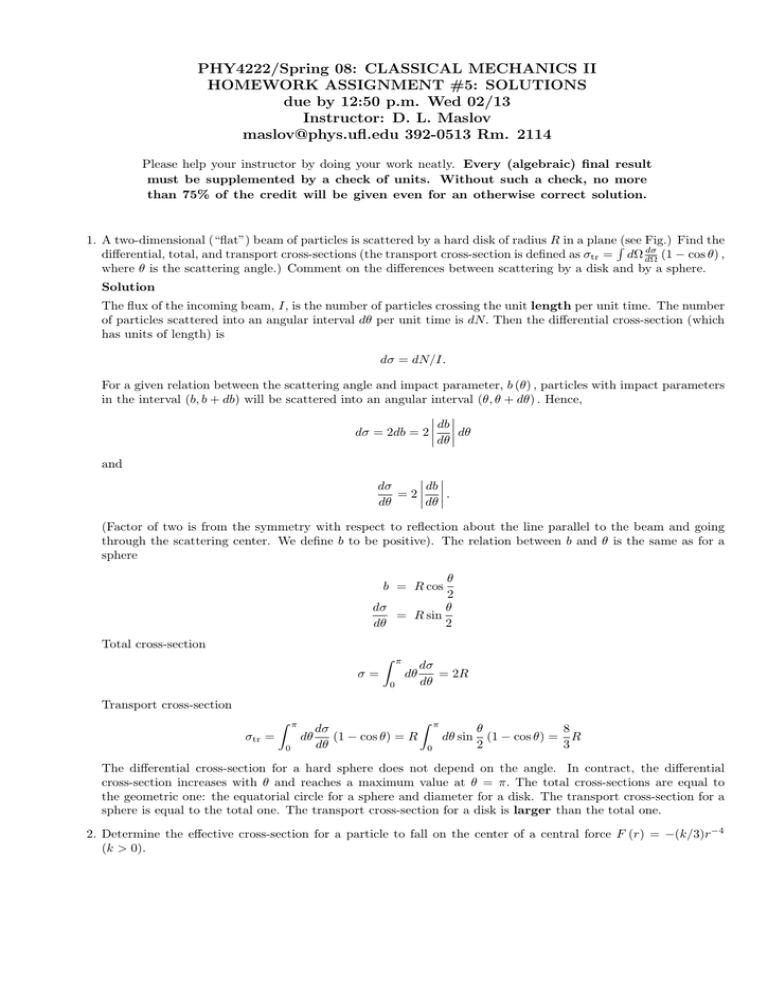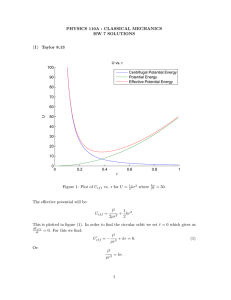PHY4222/Spring 08: CLASSICAL MECHANICS II HOMEWORK ASSIGNMENT #5: SOLUTIONS
advertisement

PHY4222/Spring 08: CLASSICAL MECHANICS II HOMEWORK ASSIGNMENT #5: SOLUTIONS due by 12:50 p.m. Wed 02/13 Instructor: D. L. Maslov maslov@phys.ufl.edu 392-0513 Rm. 2114 Please help your instructor by doing your work neatly. Every (algebraic) final result must be supplemented by a check of units. Without such a check, no more than 75% of the credit will be given even for an otherwise correct solution. 1. A two-dimensional (“flat”) beam of particles is scattered by a hard disk of radius R in a planeR(see Fig.) Find the dσ (1 − cos θ) , differential, total, and transport cross-sections (the transport cross-section is defined as σtr = dΩ dΩ where θ is the scattering angle.) Comment on the differences between scattering by a disk and by a sphere. Solution The flux of the incoming beam, I, is the number of particles crossing the unit length per unit time. The number of particles scattered into an angular interval dθ per unit time is dN. Then the differential cross-section (which has units of length) is dσ = dN/I. For a given relation between the scattering angle and impact parameter, b (θ) , particles with impact parameters in the interval (b, b + db) will be scattered into an angular interval (θ, θ + dθ) . Hence, db dσ = 2db = 2 dθ dθ and db dσ = 2 . dθ dθ (Factor of two is from the symmetry with respect to reflection about the line parallel to the beam and going through the scattering center. We define b to be positive). The relation between b and θ is the same as for a sphere θ 2 dσ θ = R sin dθ 2 b = R cos Total cross-section Z σ= π dθ 0 dσ = 2R dθ Transport cross-section Z σtr = π dθ 0 dσ (1 − cos θ) = R dθ Z π dθ sin 0 θ 8 (1 − cos θ) = R 2 3 The differential cross-section for a hard sphere does not depend on the angle. In contract, the differential cross-section increases with θ and reaches a maximum value at θ = π. The total cross-sections are equal to the geometric one: the equatorial circle for a sphere and diameter for a disk. The transport cross-section for a sphere is equal to the total one. The transport cross-section for a disk is larger than the total one. 2. Determine the effective cross-section for a particle to fall on the center of a central force F (r) = −(k/3)r−4 (k > 0). 2 Solution The potential energy corresponding to this force is U (r) = −k/9r3 . effective potential energy is Uef f (r) = −k/9r3 + M 2 /2mr2 = −k/9r3 + Eb2 /r2 . For r → 0, Uef f is large and negative. For r → ∞, Uef f is small and positive. In between, Uef f goes through a maximum determined from b2 k k dUef f . = 0 → 4 − 2E 3 = 0 → rm = dr 3rm rm 6Eb2 Indermediate unit check rm = b k . 6Eb3 The units of k/b3 is energy, energy over energy is dimensionless. The units of rm is the same as of b (m) . OK. The maximum value of Uef f 3 2 6Eb2 63 E 3 b6 E 3 b6 k 6Eb2 + Eb2 =− + 62 2 2 9 k k 9 k k 3 6 3 6 E b 2 E b = 12 2 = 36 1 − 3 k2 k max Uef f = − Intermediate unit check max Uef f = 12E Since k/Eb3 2 E 2 b6 k2 max is dimensionless, the units of Uef f are the same as of E (energy) . OK. max A particle coming from infinity can reach the center (r = 0) only if it is energy is larger than Uef f k2 E 2 b6 1/3 E ≥ 12E 2 → b6 ≤ 12 2 → b2 ≤ b2max = (12) k E k E 2/3 The cross-section is σc = πb2max = π (12) 2/3 Final units check: [k] /[E] = m3 , [σc ] = ([k] /[E]) 1/3 k E 2/3 . = m2 . OK. 3. T&M 9.52 Solution The number of events scattering incident particles by angle θ in the C.O.M. system dN ∝ σ (θ) sin θdθ = σ (θ) d (− cos θ) From Eq.(9.87a) in the book, T2 2m1 m2 = 2 (1 − cos θ) . T1 (m1 + m2 ) Solving for cos θ, cos θ = Tm − 2T2 , Tm . 3 where Tm = 4m1 m2 2 T1 (m1 + m2 ) is the maximum kinetic energy of the recoil particle. d (− cos θ) = 2dT2 Tm Hence the distribution of recoil particles is given by dT2 −1 Tm − 2T2 dN2 ∝ σ (θ) d (− cos θ) = 2σ cos Tm Tm 4. Bonus: Find the differential scattering cross-section in a potential U = α/r2 (α > 0). Solution For any central field, the energy conservation gives r m dr q dt = 2 E − M2 − U 2mr 2 The angular momentum is M = r2 φ̇ or dt = (r2 /M )dφ or r M/r2 m q dφ = dr 2 E − M2 − U 2mr 2 Integrating this relation from the distance of maximum approach to infinity, we obtain r Z ∞ M/r2 m q φ0 = dr, 2 rmin E − M 2 − U 2 2mr where φ0 is the angle to the asymptote of the trajectory. Using M = Eb2 /r2 , we find Z ∞ b/r2 dr q φ0 = . 2 U rmin 1 − rb2 − E rmin is the root of the determinant. For U = α/r2 , we introduce a new variable x = b/r and the integral reduces to Z xmin dx p φ0 = , 2 1 − x [1 + α/b2 E] 0 p where xmin is found from 1 = x2min 1 + α/b2 E → xmin = 1/ 1 + α/b2 E. Re-writing the integral as Z xmin dx p φ0 = 1 − x2 /x2min 0 and introducing yet another variable y = x/xmin , we obtain Z 1 π 1 dy π p φ0 = xmin = xmin = p 2 2 2 1 + α/b2 E 1−y 0 The scattering angle θ = π − 2φ0 = π 1 − p 1 1 + k/b2 E ! . 4 Solving this for b2 = b2 (θ) gives b2 = α/E 1 − (1 − θ/π) −2 Differentiating the last result gives db 2α 1 − θ/π 2b = dθ πE (θ/π)2 (2 − θ/π)2 The differential cross-section is σ (θ) = b sin θ db α 1 − θ/π = dθ πE sin θ (θ/π)2 (2 − θ/π)2







